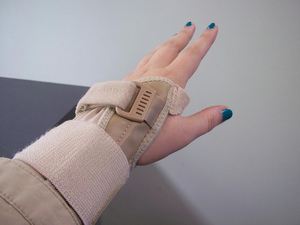Last week, a new patient asked me, “Should I have carpal tunnel surgery?” My immediate response was, “once you’re cut — opened up by surgery — you can’t be uncut. Make sure it truly is carpal tunnel before you opt for surgical intervention.”
Carpal tunnel syndrome (CTS) occurs when the median nerve — a nerve from the elbow down the forearm into the palm of the hand — becomes pressed or squeezed at the wrist bones or carpals.
The most precise method to diagnose carpal tunnel syndrome (CTS) is by using a patient’s symptoms in combination with electro-diagnostic testing such as nerve conduction studies or electromyography. These tests have limitations, however. For example, obesity can slow the rate of conduction along the path of a nerve. Also, women and seniors tend to have slower conduction rates than young, fit males.
The first step to obtaining an accurate diagnosis include ruling out other conditions. These include degenerative joint disease, commonly known as osteoarthritis, rheumatoid arthritis, diabetes, and thyroid pathologies, among others. Each of these conditions can cause numbness and tingling in the hand and fingers, symptoms mimicking CTS.
Further, it is important understand a bit about anatomy. Nerves are formed from nerve roots, which leave the spinal cord and exit the spinal column. These roots merge, then split, then merge again with off-shoots of other nerve roots and form nerves. Nerves travel past, through or between muscles.
The structures around the nerve can be what cause CTS-like symptoms. For example, if you have a herniated disk (also known as a slipped or bulging disk) in your neck, you may think you have CTS. Here, however, the problem is the bulging disk in your neck, and not a problem with your wrist. The disk may be interfering with the spinal cord or a nerve root. Treatment for these is very different that what’s required for treating CTS.
Another factor that may trigger CTS -ike symptoms is thoracic outlet or scalene syndrome. The three scalene muscles are located in your neck, forming a triangle with the collar bone. Parts of the median nerve pass through this outlet on its way down the arm. If injured or chronically tight due to stress, the scalenes will impinge upon the nerve, and trigger discomfort, tingling and loss of sensation in the hand.
Another muscle that may affect the median nerve’s ability to function is the pronator teres. Found in the forearm, this muscle allows you to position your hand palm down. If the nerve is trapped within the pronator teres or if this muscle is injured or chronically tight or short it, too, will cause CTS-like symptoms.
These two muscle entrapment conditions can be conservatively and easily treated with massage therapy, chiropractic and stretching.
In women, the symptoms associated with CTS may be caused by water retention due to hormonal fluctuations or pregnancy. In some individuals, CTS symptoms may be caused by a deficiency in vitamin B6.1
Before you opt for carpal tunnel surgery, know your options. And above all, make sure you actually do have CTS.
1Prior to beginning a course of supplementation, discuss this option with your doctor or chiropractor.
Sources:
Piazzini DB, Aprile I, Ferrara PE, et al. A systematic review of conservative treatment of carpal tunnel syndrome. Clin Rehabil. 2007;21(4):299-314.
http://www.ninds.nih.gov/disorders/carpal_tunnel/detail_carpal_tunnel.htm
http://www.umm.edu/patiented/articles/how_carpal_tunnel_syndrome_diagnosed_000034_7.htm#ixzz2NX3pIrSW



